light CADILLAC DEVILLE 1998 7.G User Guide
[x] Cancel search | Manufacturer: CADILLAC, Model Year: 1998, Model line: DEVILLE, Model: CADILLAC DEVILLE 1998 7.GPages: 386, PDF Size: 22.36 MB
Page 72 of 386
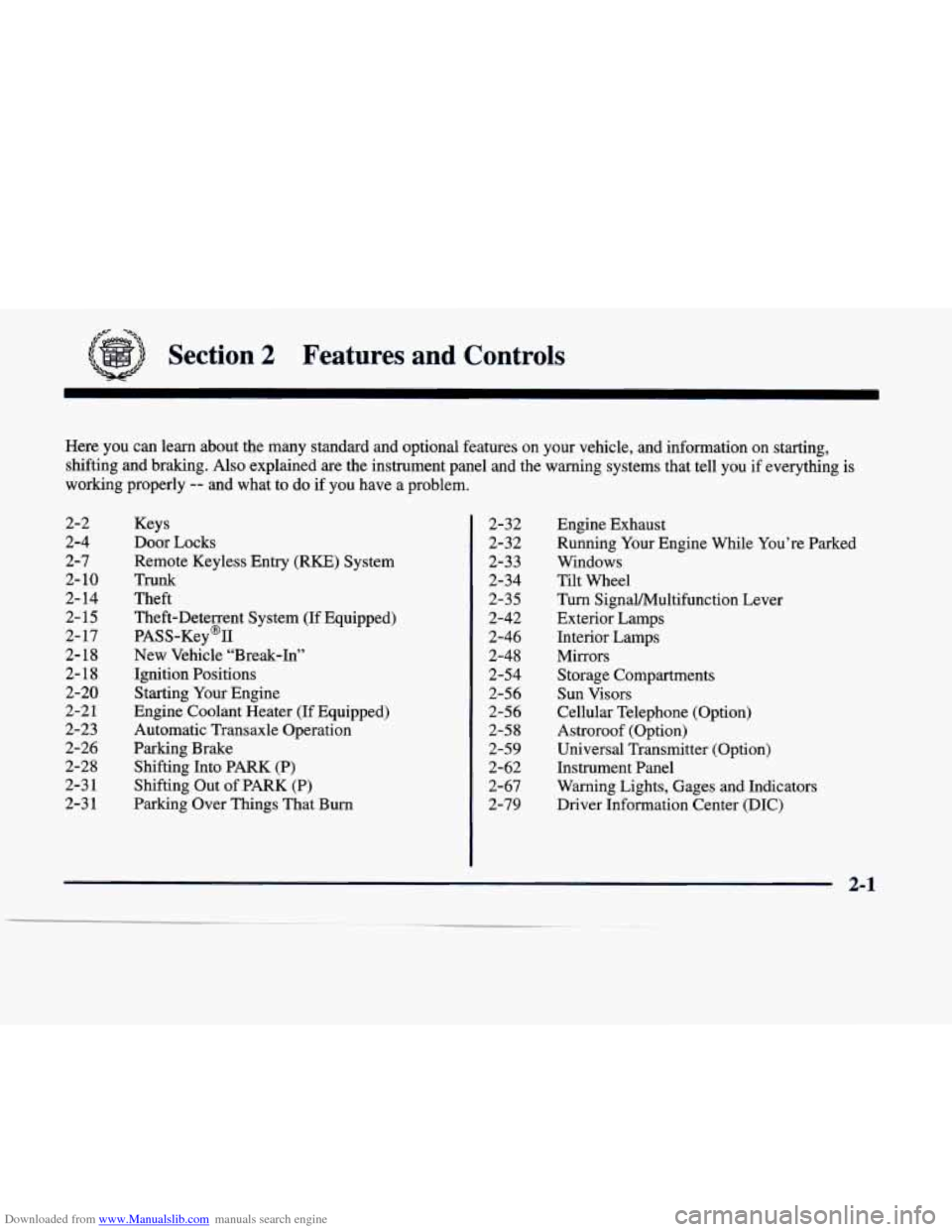
Downloaded from www.Manualslib.com manuals search engine Features and Controls
Here you can learn about the many standard and optional features on your ve\
hicle, and information on starting,
shifting
and braking. Also explained are the instrument panel and the warning systems that tell you if everything is
working properly
-- and what to do if you have a problem.
2-2
2-4
2-7
2- 10
2- 14 2-15
2-17
2- 18
2-18
2-20
2-2
1
2-23
2-26
2-28
2-3
1
2-3 1 Keys
Door Locks
Remote Keyless Entry (RKE) System
Trunk
Theft Theft-Deterrent System (If Equipped)
PASS-Key’II
New Vehicle “Break-In’’
Ignition Positions
Starting Your Engine
Engine Coolant Heater (If Equipped)
Automatic Transaxle Operation
Parking Brake Shifting Into PARK
(P)
Shifting Out of PARK (P)
Parking Over Things That Burn 2-32
2-32
2-33
2-34
2-35 2-42
2-46
2-48
2-54
2-56
2-56
2-5 8
2-59
2-62
2-67
2-79 Engine Exhaust
Running Your Engine While You’re Parked
Windows
Tilt Wheel
Turn SignaUMultifunction Lever
Exterior Lamps
Interior Lamps
Mirrors
Storage Compartments
Sun Visors
Cellular Telephone (Option)
Astroroof (Option)
Universal Transmitter (Option)
Instrument Panel
Warning Lights, Gages and Indicators Driver Information Center (DIC)
Page 85 of 386
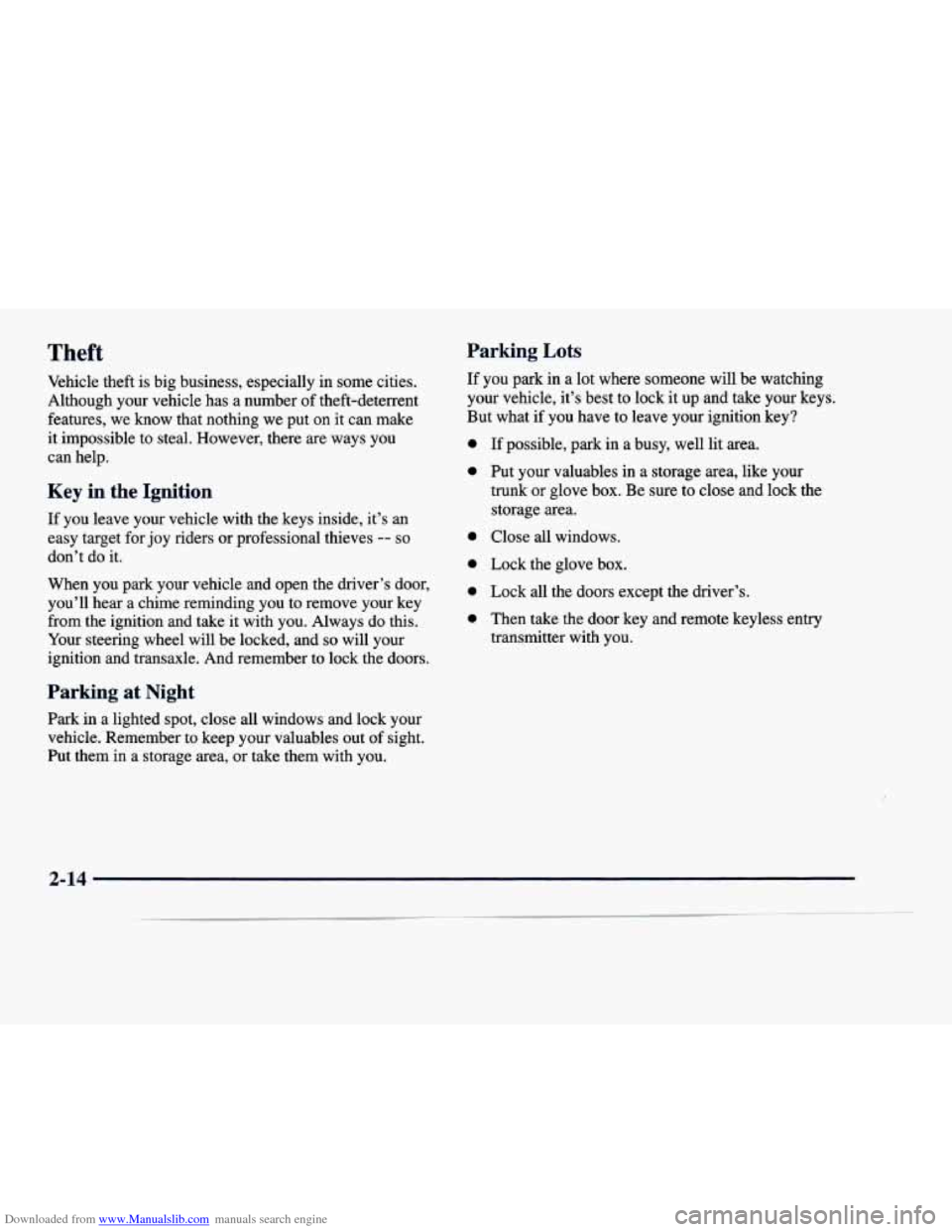
Downloaded from www.Manualslib.com manuals search engine Theft Parking Lots
Vehicle theft is big business, especially in some cities.
Although your vehicle has a number of theft-deterrent
features, we know that nothing we put on it can make
it impossible to steal. However, there are ways you
can help.
Key in the Ignition
If you leave your vehicle with the keys inside, it’s an
easy target for joy riders or professional thieves -- so
don’t do it.
When you park your vehicle and open the driver’s door, you’ll hear a chime reminding you to remove your key
from the ignition and take
it with you. Always do this.
Your steering wheel will be locked, and
so will your
ignition and transaxle. And remember to lock the doors.
Parking at Night
Park in a lighted spot, close all windows and lock your
vehicle. Remember to keep your valuables out of sight.
Put them in a storage area,
or take them with you. If you park in
a lot where someone will be watching
your vehicle, it’s best to lock it
up and take your keys.
But what if you have to leave your ignition key?
0
0
0
0
0
0
If possible, park in a busy, well lit area.
Put your valuables
in a storage area, like your
trunk or glove
box. Be sure to close and lock the
storage area.
Close all windows.
Lock the glove
box.
Lock all the doors except the driver’s.
Then take the door key and remote keyless entry
transmitter with you.
2-14
Page 86 of 386
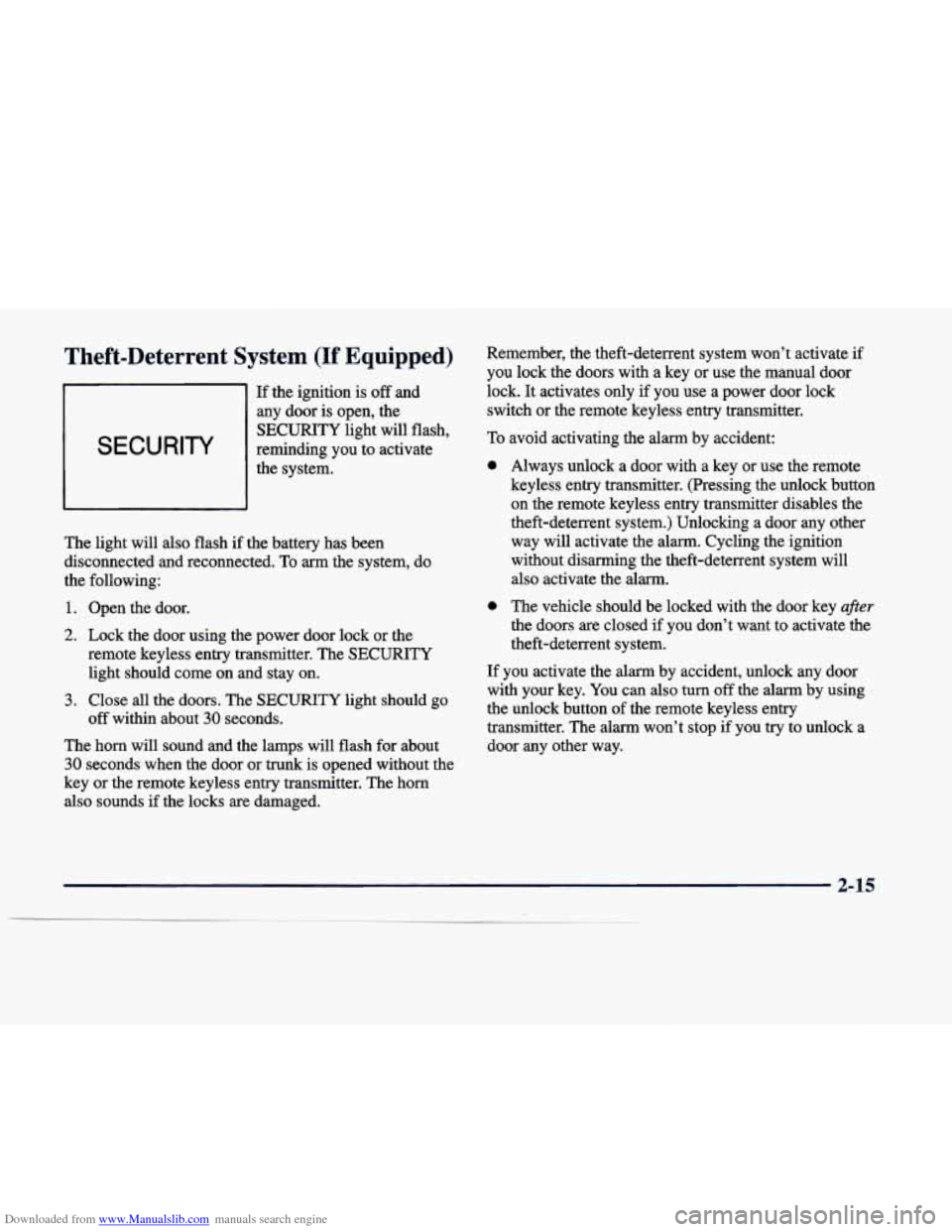
Downloaded from www.Manualslib.com manuals search engine Theft-Deterrent System (If Equipped) Remember, the theft-deterrent system won’t activate if
you lock the doors with a key or use the manual door
If the ignition
is off and lock.
It activates only if you use a power door lock
any door
is open, the switch or the remote keyless entry transmitter.
SECURITY
SECURITY
light will flash,
reminding you to activate
the system. To
0
The light will also flash if the battery has been
disconnected and reconnected. To arm the system, do
the following:
1. Open the door.
2. Lock the door using the power door lock or the
remote keyless entry transmitter. The SECURITY
light should come on and stay on.
3. Close all the doors. The SECURITY light should go
The horn will sound and the lamps will flash for about
30 seconds when the door or trunk is opened without the
key or the remote keyless entry transmitter. The horn
also sounds if the locks
are damaged.
off within about
30 seconds. avoid activating
the alarm by accident:
Always unlock a door with a key or use the remote
keyless entry transmitter. (Pressing the unlock button
on the remote keyless entry transmitter disables the
theft-deterrent system.) Unlocking a door any other
way will activate the alarm. Cycling the ignition
without disarming the theft-deterrent system will
also activate the alarm.
The vehicle should be locked with the door key
after
the doors are closed if you don’t want to activate the
theft-deterrent system.
If you activate the alarm by accident, unlock any door with your key. You can also
turn off the alarm by using
the unlock button of the remote keyless entry
transmitter. The alarm won’t stop if you try to unlock a
door any other way.
2-15
Page 87 of 386
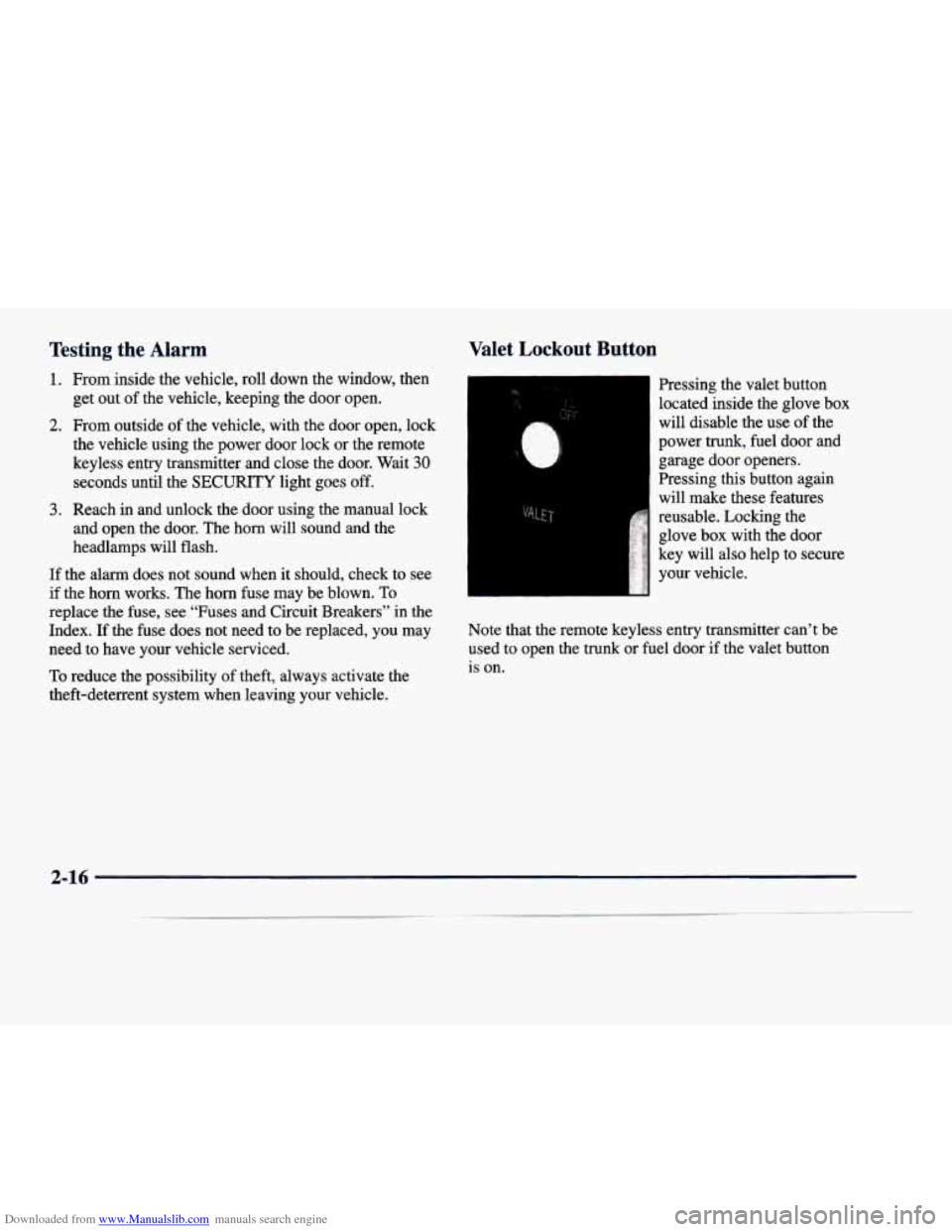
Downloaded from www.Manualslib.com manuals search engine Testing the Alarm
1. From inside the vehicle, roll down the window, then get out of the vehicle, keeping the door open.
2. From outside of the vehicle, with the door open, lock
the vehicle using the power door lock or the remote
keyless entry transmitter and close the door. Wait
30
seconds until the SECURITY light goes off.
3. Reach in and unlock the door using the manual lock
and open the door. The horn
will sound and the
headlamps will flash.
If the alarm does not sound when it should, check to see
if the horn works. The horn fuse may be blown. To
replace the fuse, see “Fuses and Circuit Breakers” in the
Index.
If the fuse does not need to be replaced, you may
need to have your vehicle serviced.
To reduce the possibility of theft, always activate the
theft-deterrent system when leaving your vehicle.
Valet Lockout Button
Pressing the valet button
located inside the glove box
will disable the use of the
power trunk, fuel door and
garage door openers.
Pressing this button again
will make these features
reusable. Locking the
glove box with the door
key will also help to secure
your vehicle.
Note that the remote keyless entry transmitter can’t be used to open the
trunk or fuel door if the valet button
is on.
2-16
Page 97 of 386
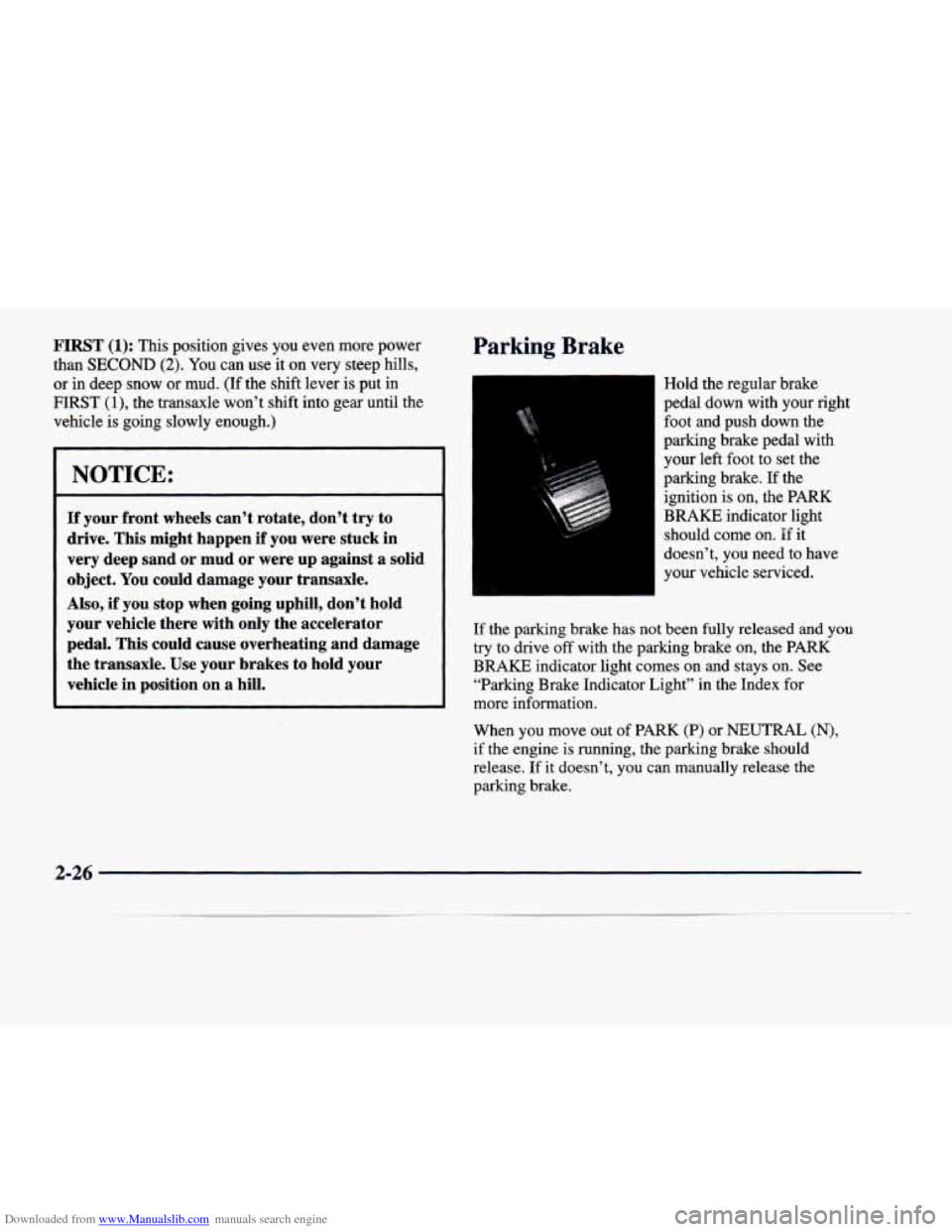
Downloaded from www.Manualslib.com manuals search engine FIRST (1): This position gives you even more power
than
SECOND (2). You can use it on very steep hills,
or
in deep snow or mud. (If the shft lever is put in
FIRST (l), the transaxle won’t shift into gear until the
vehicle is going slowly enough.)
I NOTICE:
- ~~
If your front wheels can’t rotate, don’t try to
drive. This might happen if you were stuck in
very deep sand
or mud or were up against a solid
object.
You could damage your transaxle.
Also, if you stop when going uphill, don’t hold
your vehicle there with only the accelerator
pedal. This could cause overheating and damage
the transaxle.
Use your brakes to hold your
vehicle in position on a hill.
Parking Brake
Hold the regular brake
pedal down with your right
foot and push down the
parking brake pedal with
your left foot to set the
parking brake. If the
ignition is on, the PARK
BRAKE indicator light
should come on.
If it
doesn’t, you need to have
your vehicle serviced.
If the parking brake has not been fully released and you
try to drive off with the parking brake on, the PARK
BRAKE indicator light comes on and stays on. See “Parking Brake Indicator Light” in the Index for
more information.
When you move out of PARK
(P) or NEUTRAL (N),
if the engine is running, the parking brake should
release. If it doesn’t, you can manually release the
parking brake.
2-26
Page 106 of 386
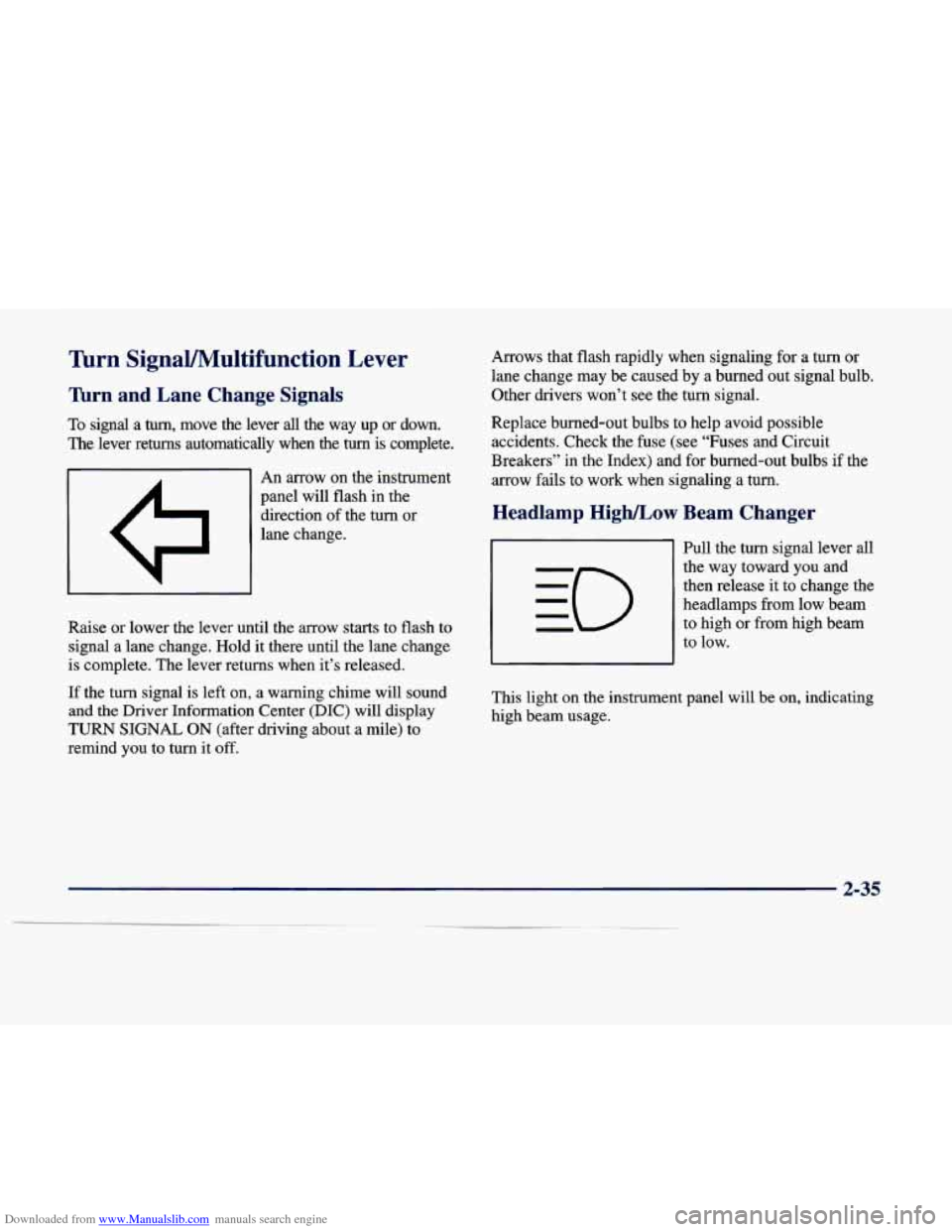
Downloaded from www.Manualslib.com manuals search engine Turn SignaVMultifunction Lever
Tbrn and Lane Change Signals
To signal a turn, move the lever all the way up or down.
The lever returns automatically when the
turn is complete.
I A I An arrow on the instrument
panel will flash in the
direction of the turn or
lane change.
Raise or lower the lever until the arrow starts
to flash to
signal a lane change. Hold it there until the lane change
is complete. The lever returns when it’s released.
If the turn signal
is left on, a warning chime will sound
and the Driver Information Center (DIC) will display
TURN SIGNAL ON (after driving about a mile) to
remind you to turn it off. Arrows that
flash rapidly when signaling for a turn or
lane change may be caused by a burned out signal bulb.
Other drivers won’t see the turn signal.
Replace burned-out bulbs to help avoid possible accidents. Check the fuse (see “Fuses and Circuit
Breakers” in the Index) and for burned-out bulbs if the
arrow fails
to work when signaling a turn.
Headlamp High/Low Beam Changer
Pull the turn signal lever all
the way toward you and
then release it to change the
headlamps from low beam
to high or from high beam
to low.
This light on the instr..__lent panel will
be on, indicating
high beam usage.
Page 112 of 386
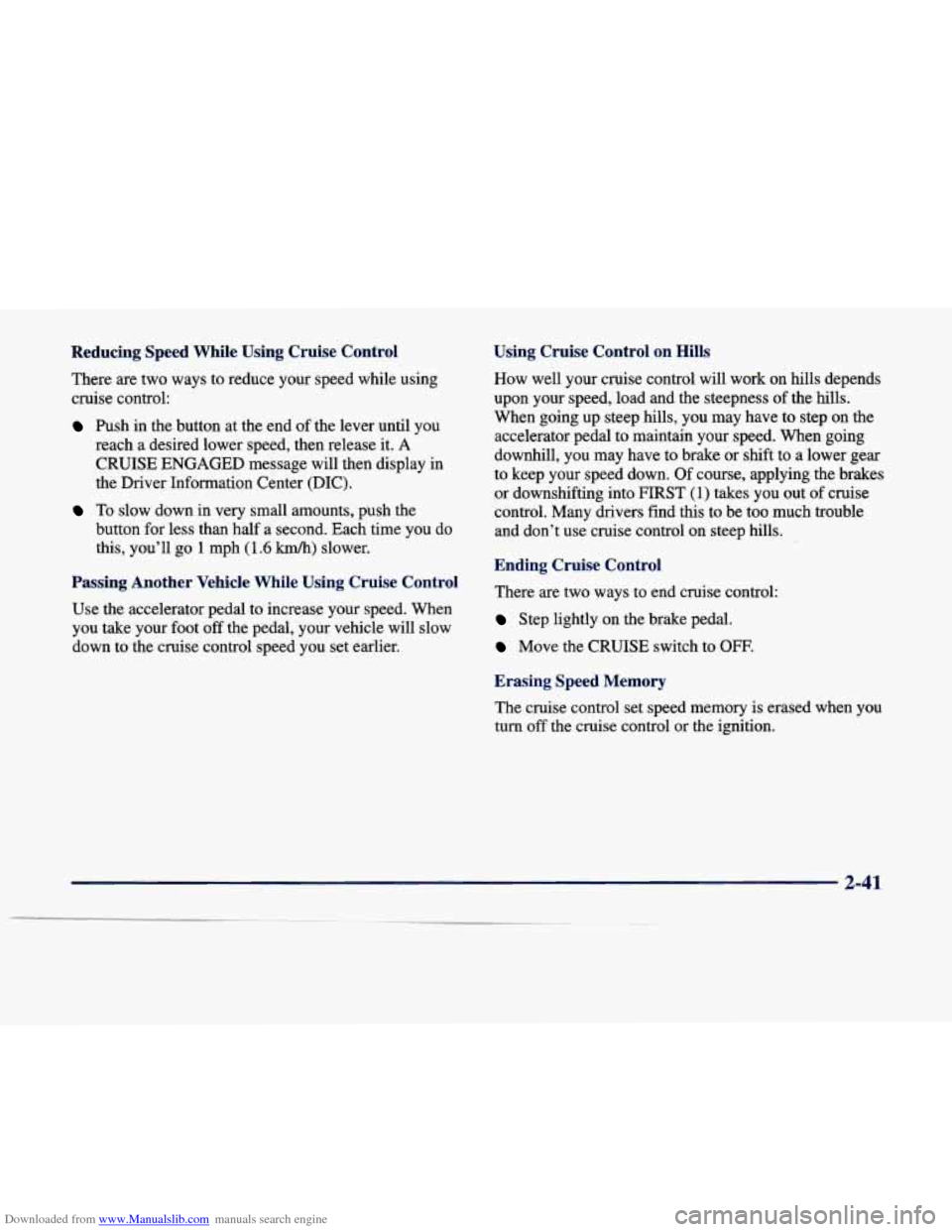
Downloaded from www.Manualslib.com manuals search engine Reducing Speed While Using Cruise Control
There are two ways to reduce your speed while using
cruise control:
Push in the button at the end of the lever until you
reach a desired lower speed, then release it.
A
CRUISE ENGAGED message will then display in
the Driver Information Center (DIC).
To slow down in very small amounts, push the
button for less than half a second. Each time you do
this, you’ll go
1 mph (1.6 km/h) slower.
Passing Another Vehicle While Using Cruise Control
Use the accelerator pedal to increase your speed. When
you take your foot
off the pedal, your vehicle will slow
down to the cruise control speed you set earlier.
Using Cruise Control on Hills
How well your cruise control will work on hills depends
upon your speed, load and the steepness of the hills.
When going up steep hills, you may have to step on the
accelerator pedal
to maintain your speed. When going
downhill, you may have to brake or shift to. a lower gear to keep your speed down. Of course, applying the brakes
or downshifting into FIRST
(1) takes you out of cruise
control. Many drivers find this to be too much trouble
and don’t use cruise control on steep hills.
Ending Cruise Control
There are two ways to end cruise control:
Step lightly on the brake pedal.
Move the CRUISE switch to OFF.
Erasing Speed Memory
The cruise control set speed memory is erased when you
turn
off the cruise control or the ignition.
2-41
Page 113 of 386
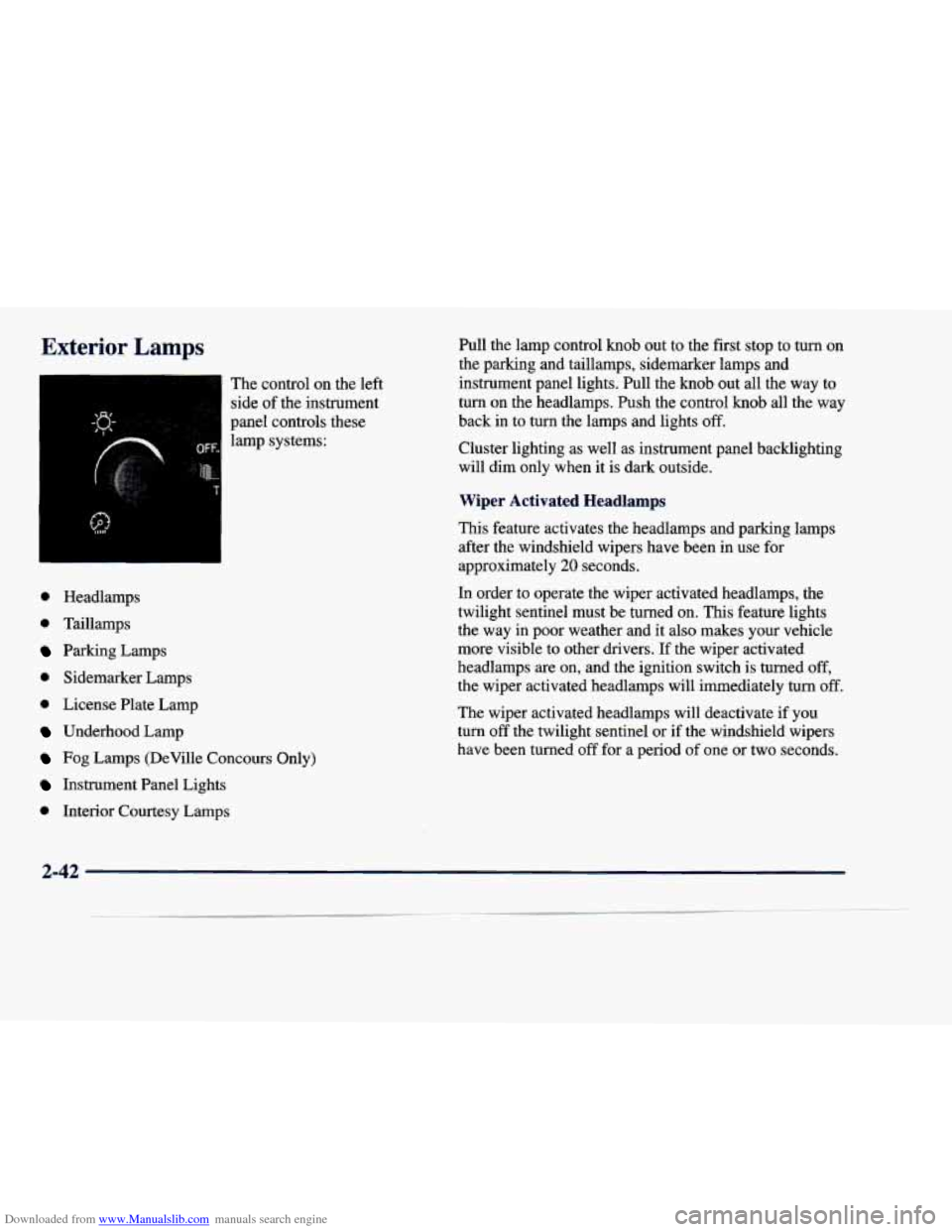
Downloaded from www.Manualslib.com manuals search engine Exterior Lamps
The control on the left side of the instrument
panel controls these
lamp systems:
0 Headlamps
0 Taillamps
Parking Lamps
0 Sidemarker Lamps
0 License Plate Lamp
Underhood Lamp
Fog Lamps (DeVille Concours Only)
Instrument Panel Lights
0 Interior Courtesy Lamps Pull the lamp control knob out to the
first stop to turn on
the parking and taillamps, sidemarker lamps and
instrument panel lights. Pull the knob out all the way to
turn
on the headlamps. Push the control knob all the way
back
in to turn the lamps and lights off.
Cluster lighting as well as instrument panel backlighting
will dim only when
it is dark outside.
Wiper Activated Headlamps
This feature activates the headlamps and parking lamps
after the windshield wipers have been in use for
approximately
20 seconds.
In order to operate the wiper activated headlamps, the
twilight sentinel must be turned on. This feature lights
the way in poor weather and it also makes your vehicle
more visible to other drivers. If the wiper activated
headlamps are on, and the ignition switch is turned off,
the wiper activated headlamps will immediately turn
off.
The wiper activated headlamps will deactivate if you
turn
off the twilight sentinel or if the windshield wipers
have been turned
off for a period of one or two seconds.
2-42
Page 114 of 386
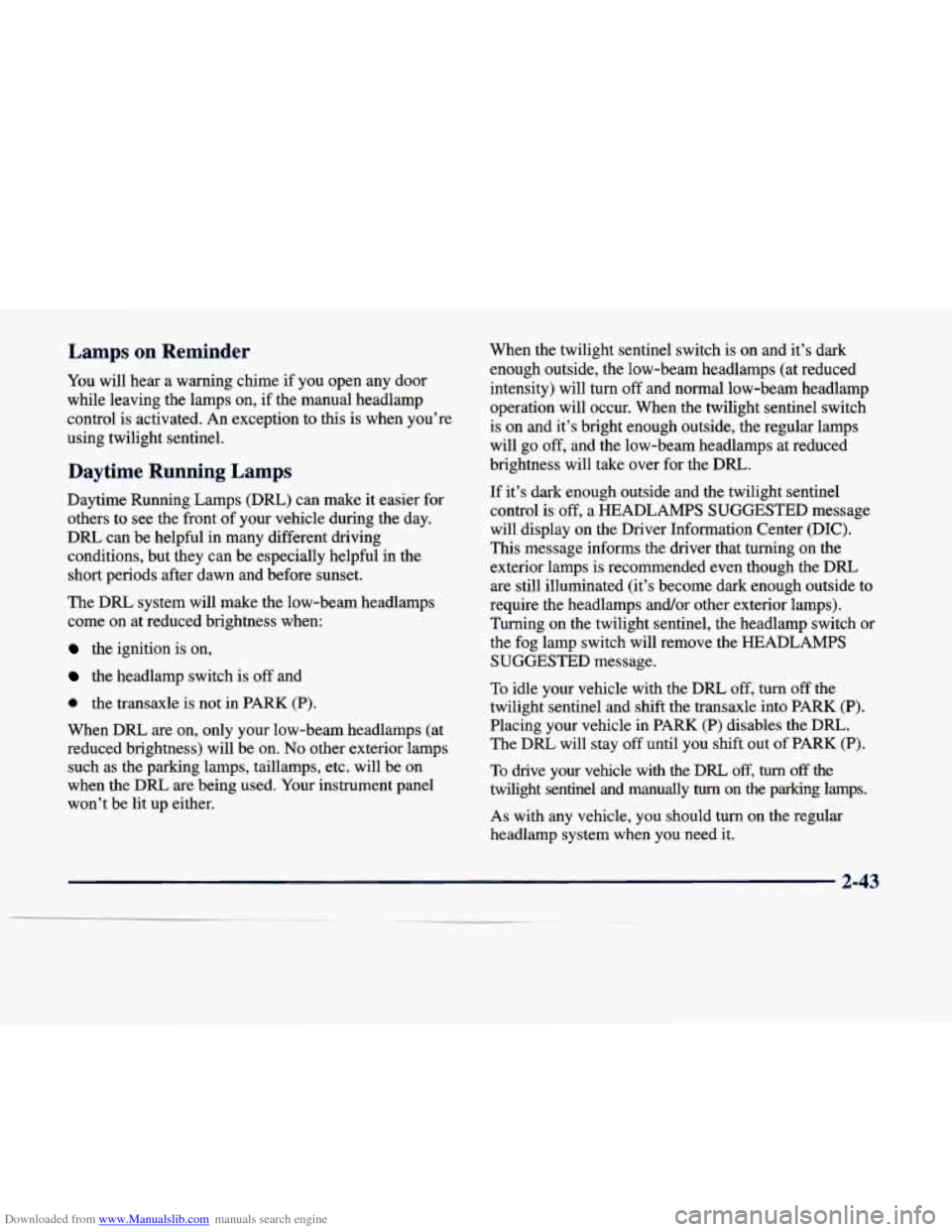
Downloaded from www.Manualslib.com manuals search engine Lamps on Reminder
You will hear a warning chime if you open any door
while leaving the lamps
on, if the manual headlamp
control is activated. An exception to this is when you’re
using twilight sentinel.
Daytime Running Lamps
Daytime Running Lamps (DRL) can make it easier for
others to see the front
o€ your vehicle during the day.
DRL can be helpful in many different driving
conditions, but they can be especially helpful in the
short periods after dawn and before sunset.
The DRL system will make the low-beam headlamps
come on at reduced brightness when:
the ignition is on,
the headlamp switch is off and
0 the transaxle is not in PARK (P).
When DRL are on, only your low-beam headlamps (at
reduced brightness) will be on.
No other exterior lamps
such as the parking lamps, taillamps, etc. will be on
when the DRL are being used. Your instrument panel won’t be lit up either. When
the twilight sentinel switch is on and it’s dark
enough outside, the low-beam headlamps (at reduced
intensity) will turn
off and normal low-beam headlamp
operation will occur. When the twilight sentinel switch
is on and it’s bright enough outside, the regular lamps
will go
off, and the low-beam headlamps at reduced
brightness will take over for the
Dm.
If it’s dark enough outside and the twilight sentinel
control
is off, a HEADLAMPS SUGGESTED message
will display on the Driver Information Center (DIC).
This message informs the driver that turning
on the
exterior lamps is recommended even though the DRL
are still illuminated (it’s become dark enough outside to
require the headlamps and/or other exterior lamps).
Turning on the twilight sentinel, the headlamp switch or
the fog lamp switch will remove the HEADLAMPS
SUGGESTED message.
To idle your vehicle with the DRL off, turn off the
twilight sentinel and shift the transaxle into PARK
(P).
Placing your vehicle in PARK (P) disables the Dm.
The DRL will stay off until you shift out of PARK (P).
To drive your vehicle with the DRL off, turn off the
twilight sentinel and manually
turn on the parking lamps.
As with any vehicle, you should turn on the regular
headlamp system when you need
it.
2-43
Page 115 of 386
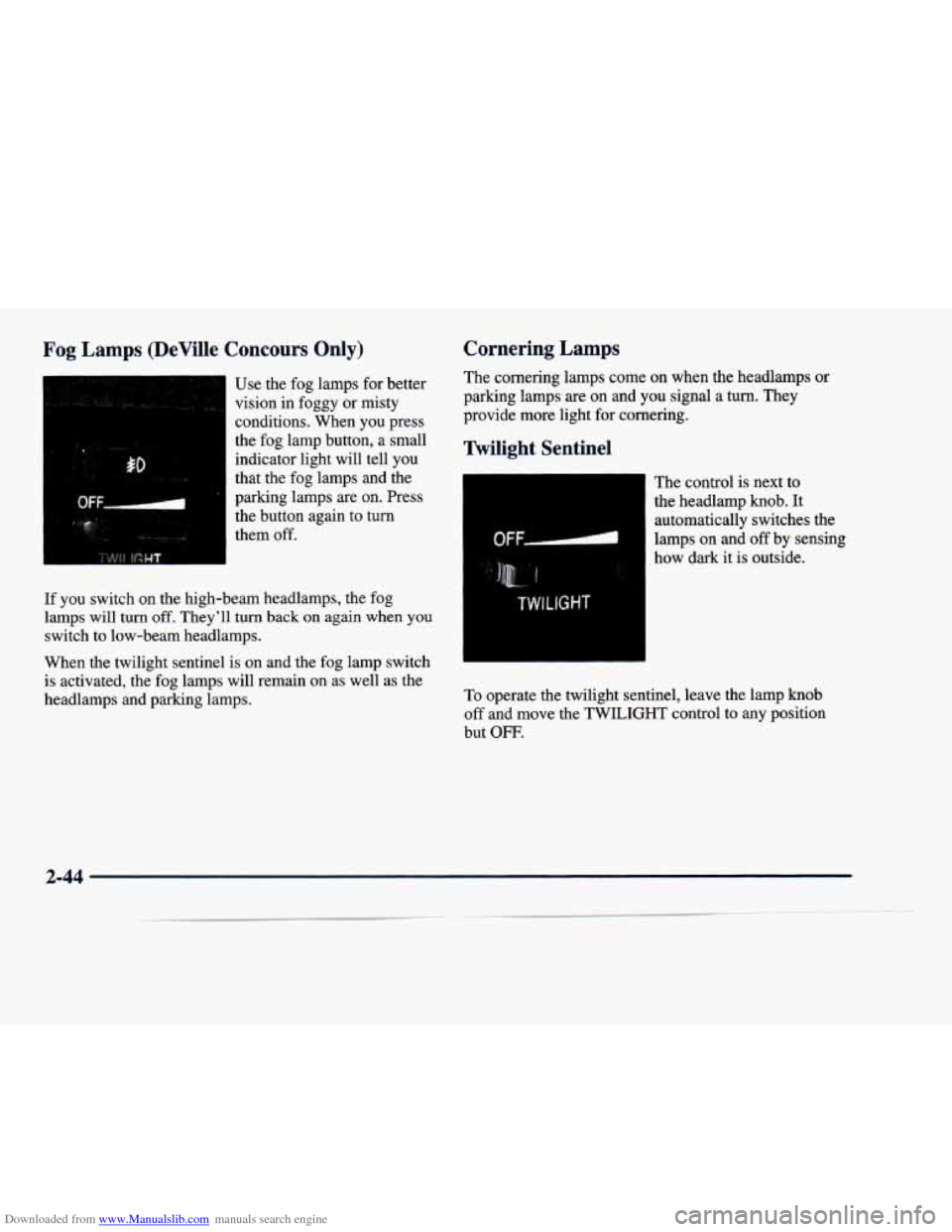
Downloaded from www.Manualslib.com manuals search engine Fog Lamps (DeVille Concours Only)
Use the fog lamps for better
vision in foggy or misty
conditions. When you press
the fog lamp button, a small
indicator light will tell you
that the fog lamps and the
parking lamps are on. Press
the button again to turn
them off.
If you switch
on the high-beam headlamps, the fog
lamps will
turn off. They'll turn back on again when you
switch to low-beam headlamps.
When the twilight sentinel is
on and the fog lamp switch
is activated, the fog lamps will remain on as well as the
headlamps and parking lamps.
Cornering Lamps
The cornering lamps come on when the headlamps or
parking lamps are on and you signal a turn. They
provide more light for cornering.
Twilight Sentinel
f
TWILIGHT
The control is next to
the headlamp knob. It
automatically switches the
lamps on and
off by sensing
how dark it
is outside.
To operate the twilight sentinel, leave the lamp knob
off and move the TWILIGHT control to any position
but
OFF.
2-44